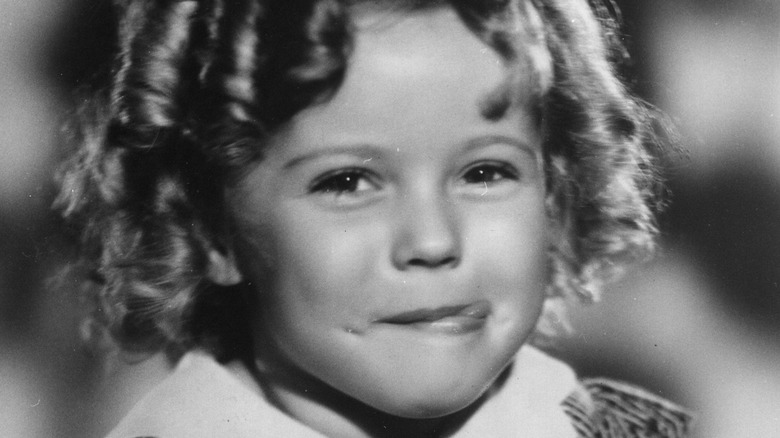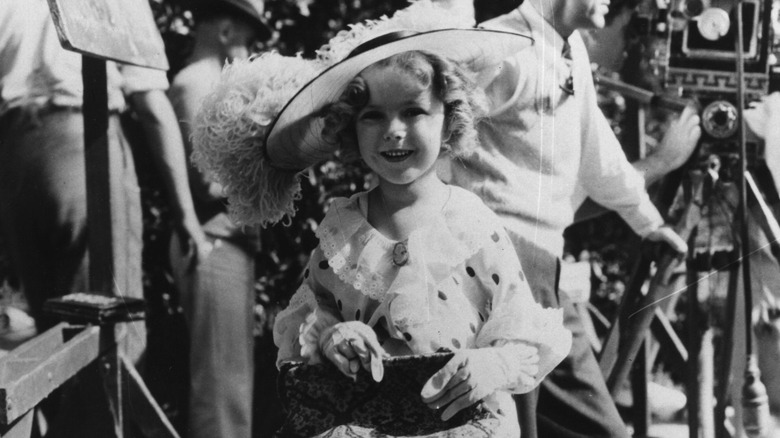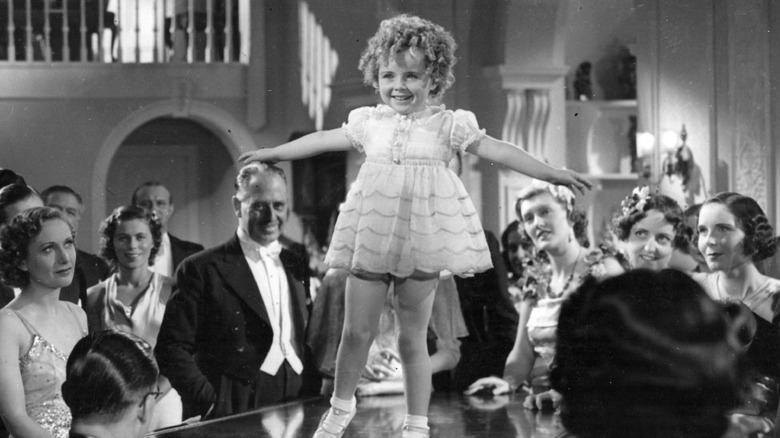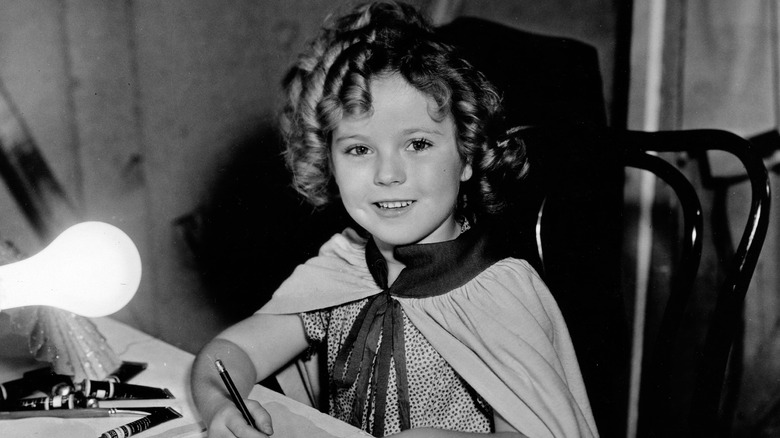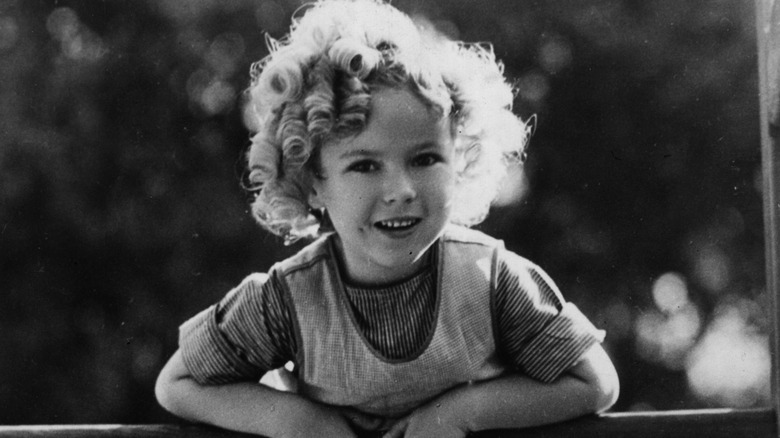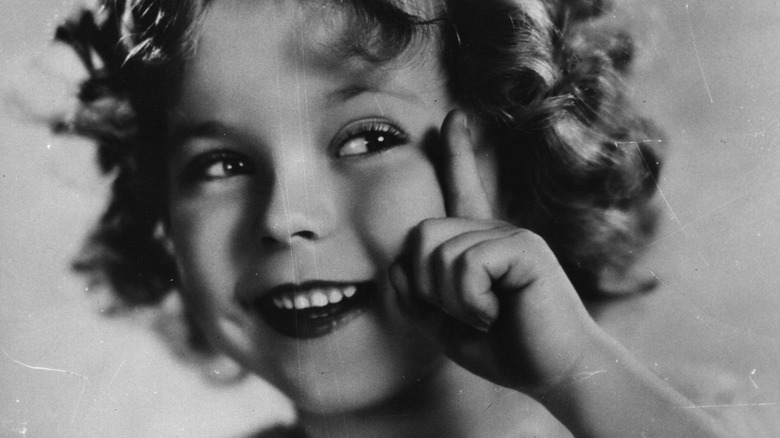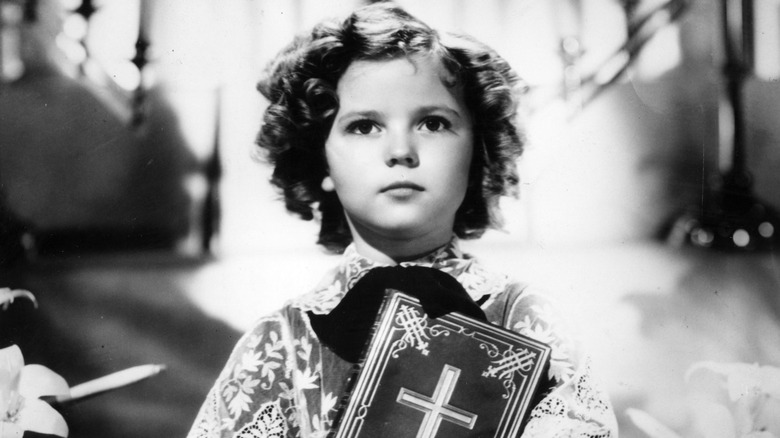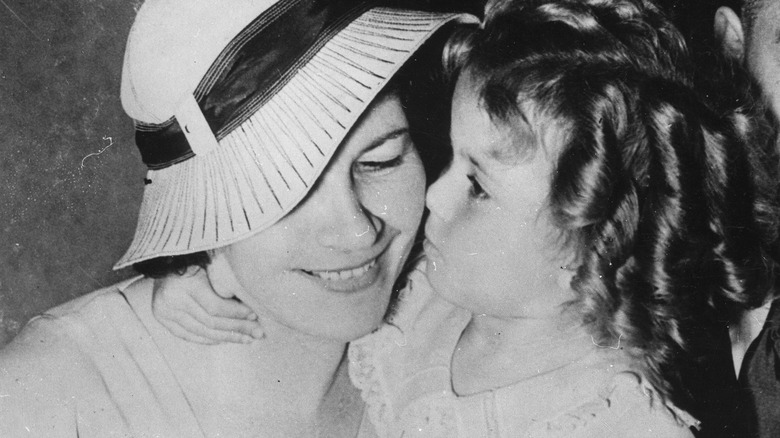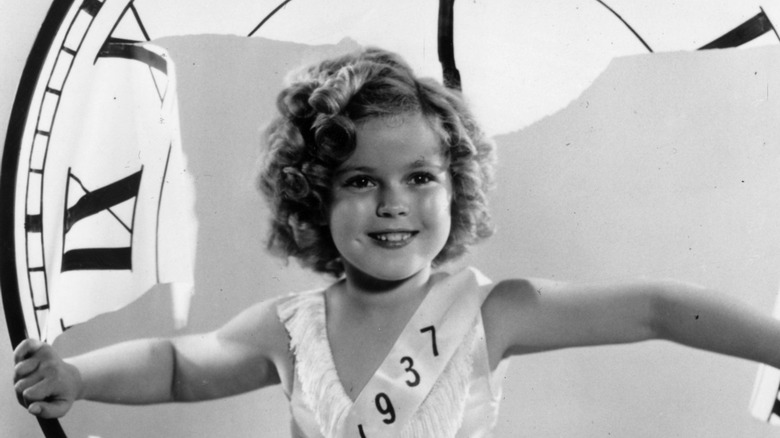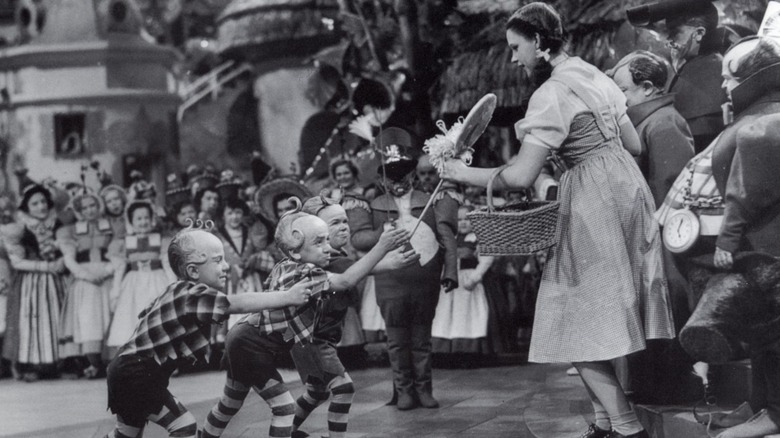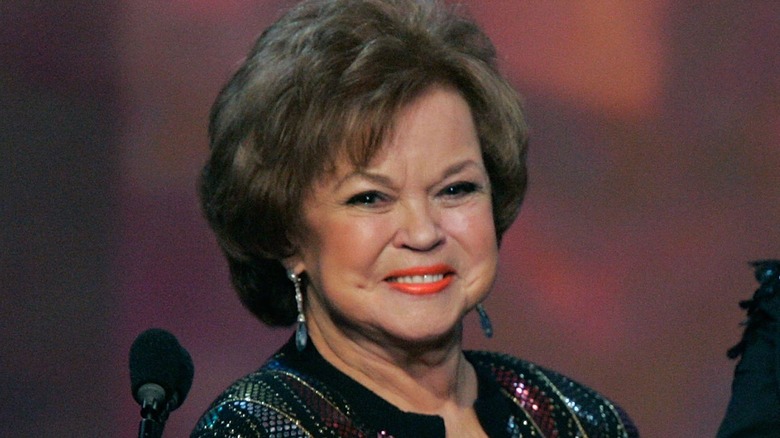Crazy Things People Used To Believe About Shirley Temple
To younger generations, Shirley Temple is seen as the happy-go-lucky blonde child star, known for her cutesy performances such as "On The Good Ship Lollipop" from 1934's "Bright Eyes." That being said, she was so much more than that. Rising to the A-list during the Great Depression in the 1930s, she was dubbed "Little Miss Miracle" by President Franklin D. Roosevelt for keeping the public morale high, even going as far as to claim, "As long as our country has Shirley Temple, we will be all right" (via Biography).
Making her acting debut in 1932, by the end of the '40s, Temple had almost starred in a whopping 60 flicks. As she grew into a young woman, interest in her acting faded, and as BBC points out, she remarkably retired "at the age of 21" — usually an age when most actors are finding their footing. Leaving the spotlight, Shirley Temple still worked, yet used her influence to pursue a career as a "politician and diplomat" (via BBC). In 2014, she died at the age of 85.
Throughout her remarkable acting career (and even after), some bizarre rumors have persisted about her. Some were truly cruel, while others were just plain weird. Let's look at the crazy things people used to believe about Shirley Temple.
Studio executives lied about Shirley Temple's age
Shirley Temple's beginnings on-screen were uncomfortable, to say the least. As recalled by Time, when she was merely five years old, she starred in an "odd" short film series titled "Baby Burlesks" — and it's definitely bizarre. These shorts saw "a bunch of toddlers in diapers" placed in adult situations, such as one of Temple's scenes where she "[trades] kisses for lollipops and says things like 'I'm expensive.'"
By her sixth birthday, the star's career was finally taking off, yet her age was still a focal point. According to her biography, "Child Star," she signed with 20th Century Fox in 1934, with studio executive Winfield R. Sheehan announcing to the press on January 13, "Four-year-old Shirley Temple has been given a long-term contract." In actuality, Temple was six, and a mere two weeks earlier, a "public advertisement" was sent out, claiming, "Little Shirley Temple, five years old, wishes to thank Fox."
The lie didn't just end there, however. According to the actor's book, Sheehan also went out of his way to conduct "a minor forgery," altering Temple's birth certificate, and as she writes, "authenticating my precocity."
Shirley Temple was 'recreated as a natural phenomenon'
Shirley Temple surely wasn't "discovered" by 20th Century Fox at the age of six — she was technically already on her way to becoming a pro in the business. As the "Bright Eyes" actor explained while on "The Diane Rehm Show," she started doing "baby burlesques" when she was under four years old, and even by then "had a basic understanding of dancing ... [and] how to find the light" while in front of the camera. In fact, she notes, when she finally got in touch with Fox, she already "knew a lot about the craft itself."
Nevertheless, her true story wasn't exciting enough for the studio executives. As Temple revealed in her book, "Child Star," as soon as Fox faked her age, they also decided she needed to be "recreated as a natural phenomenon." This meant everyone had to play along — including Temple's mother, Gertrude, who told the public that her daughter's professionalism and talent on camera came "naturally."
Of course, there were naysayers amongst the public, especially when it came to Temple's tap dancing. As Temple wrote in her biography, to help explain this lie, the studio swiftly placed the star in the prestigious Elisa Ryan School of Dancing — which also served as "high-class stardust over [her] plebeian origins."
Fans were convinced that Shirley Temple wasn't a natural blonde
Shirley Temple was known for her bouncy blonde locks. What many don't know is that her curls initially served a purpose. As the legendary star wrote in her biography, "Child Star," the idea of placing Temple's hair in such distinct curls came from her mother, Gertrude. As Shirley explains, her natural hair was prone to frizz while in the "seashore humidity," so the curls would prevent that from happening. As her star power rose, so did the finesse of her hairstyle, "finally settling down to 56 unvarying pin curls."
Of course, even in the 1930s, trolls existed among Shirley's fans. As she explained in "Child Star," she would sometimes have "bystanders" actually attempt to "tug at [her] hair to test its authenticity." But the hair gossip didn't just stop there. It turns out, fans were even convinced that the A-lister's hair color wasn't blonde, either.
One article from the Richmond Times-Dispatch in 1936 actually set out to debunk all these rumors, declaring that her hair is real and that she's a natural blonde, having her locks "washed only with a lemon rinse such as most blondes use." Interestingly enough, the article also claimed that if the actor's hair were ever to darken, Gertrude Temple wouldn't dye it.
When Shirley Temple became sick, the public jumped to conclusions
The Shirley Temple phenomenon is hard to grasp. According to Investors Business Daily, at the height of her fame in the 1930s, it's believed she was "photographed more often than President Franklin Roosevelt." What's more, her fan clubs consisted of 384 branches — and almost 4 million members. So, when Shirley Temple fell sick at one point in 1936, the entire world took notice.
As the Richmond Times-Dispatch reported at the time, during an interview with the young actor, the telephone rang, with someone on the other line asking Shirley's mother, Gertrude, if she was sick. Speaking to Gertrude didn't squash the naysayer, however, so the phone was passed to Shirley herself for confirmation. After a brief chat, the elder Temple explained that it was an English reporter who called, "frantic" at the fact Shirley Temple was so sick, all of her hair had been cut off. "They had been phoning the studio publicity departments for two days and only the actual sound of Shirley's voice calmed their fears," the Richmond Times-Dispatch explained.
The outlet notes that phoning from across the pond at this time was no joke — with a brief conversation worth "about $500." Keep in mind that the first transatlantic phone call was made in 1927, and, according to The Conversation, even making a "coast-to-coast" phone call was expensive. In 1915, "a three-minute daytime phone call from New York City to San Francisco cost $20.70" — that's $500 today.
Shirley Temple's teeth were never filed 'to make them appear like baby teeth'
A major part of Shirley Temple's appeal in the '30s was the fact that she seemingly didn't age. As explained by History, the 1930s were the "height of Hollywood's Golden Age," and the public turned to these glamorous movies as a way to escape the bleak reality of the Great Depression. Interestingly enough, although the times were tough during this period, "it's estimated [that] up to 80 million Americans [still] went to the movies each week."
As such, Shirley Temple was the perfect cutesy superstar of this era — even though Tinseltown carefully crafted her image. As the actor herself wrote in her biography, "Child Star," her fans believed she was "timeless," and when her baby teeth started falling out, that process was covered up, too. Temple explained that as soon as she had a tooth fall out, a dentist who "did dental plates and caps" was quickly brought to the studio "with a new tooth and a can of adhesive powder," which he would then give to Temple's mother "to glue in the fake." Apparently, this trick was done "for years."
Yet this lie didn't stop the "Curly Top" actor's fans from making up their own bizarre theories. According to an article by the Richmond Times-Dispatch in 1936, there was a rumor going around at the time that Temple's teeth had been filed "to make them appear like baby teeth" — which was not the case.
Shirley Temple was not an adult in 'disguise'
As Shirley Temple grew up, the rumors about her just became more bizarre. In 1937, after she released "Wee Willie Winkie," writer Graham Greene wrote a jarring review for Night and Day — a magazine which he edited (via Slate).
"Infancy is [Shirley Temple's] disguise, her appeal is more secret and more adult," Greene wrote, adding, "Already two years ago she was a fancy little piece ... Adult emotions of love and grief glissade across the mask of childhood, a childhood skin-deep." While today, such a review would stun the public, back then, it only added fuel to the fire that was stoked the previous year. According to a 1936 article by the Richmond Times-Dispatch, there was a rumor that began in England claiming that she wasn't a child at all — "but an adult midget."
Temple and Fox ultimately "sued for libel and won" (via The Hollywood Reporter), but the young actor still went through a crazy occurrence. According to Temple's biography, "Child Star," the "official Vatican newspaper" sent high-ranking clergy member Father Silvio Massante to visit Temple in America and decide once and for all if she was a child or adult. After their meeting, he declared to Shirley's mom, Gertrude, "In Italy, as in some other countries in Europe, there is a persistent rumor that Shirley is no child at all ... [that] Shirley is a midget." As the star's mother looked on in shock, Massante concluded, "Obviously, she is not."
Shirley Temple actually hated the drink named after her
Of course, considering Shirley Temple was one of the biggest stars during the golden age of Hollywood, memorabilia affiliated with the star was sold to the masses. As one article by The New York Times that was cleverly dubbed "Before Barbie, There Was Shirley Temple" notes, this included everything from elaborate dolls to "wristwatches, drinking glasses, paper dolls, Christmas ornaments, charm necklaces and pins."
However, not all of these collectibles were approved by the pint-sized star herself. As she revealed in her book, "Child Star," people started attaching her name to certain projects such as a dress line and fashion book — both without her endorsement. Dubbing these incidents a "commercial piracy of [her] name," Temple also spoke of another creation that irked her: the making of the Shirley Temple mocktail.
Made from "grenadine syrup, fruit juices, and soda water," the actor notes that while the drink was popular, she wasn't a fan. "The drink looked like diluted blood and tasted worse," she seethingly described. So, who came up with the alcohol-free cocktail? As Temple told NPR in 1986 (via Daveland), "Those were created in the probably middle 1930s by the Brown Derby Restaurant in Hollywood and I had nothing to do with it." Case closed.
Shirley Temple didn't have a pushy stage mom
Child stars in Hollywood don't exactly have a good track record of staying out of gossip rags as they transition into adulthood. Judy Garland had a truly tragic life as she matured, while in more recent years, Lindsay Lohan's fall from grace has been heavily documented in the press. These child stars usually lack a strong parental figure: "The Wizard of Oz" star famously dubbed her mother the "real Wicked Witch of the West" (via Biography), while "The Parent Trap" actor's mom, Dina Lohan, was even seen partying with her A-list daughter "late into the night," per ABC News.
Shirley Temple, on the other hand, who the Independent called "the biggest child star of all," didn't succumb to the same pitfalls of her peers as she grew older. As the outlet notes, while many were quick to dismiss her mother, Gertrude, as another "pushy" stage mom, that wasn't the case at all. "She did not push me into anything," Shirley told People in 1988, adding, "I loved what I did."
In fact, the "Heidi" actor claims that she was the pushy one — not Gertrude. "She had the reign on me, but she knew how to release that reign so that I was able to make judgments of my own, and decisions of my own," Shirley explained on "The Diane Rehm Show," noting that sometimes, she would lead her mother towards projects she was keen on pursuing.
No, Shirley Temple did not steal someone's soul
Out of all of the rumors that made headlines during the height of Shirley Temple's fame, this one may just be craziest — and it involved an assassination attempt. According to Temple's biography, "Child Star," in 1939, when she was merely 11, the A-lister was set to appear on a radio show for a Christmas special and perform "Silent Night." In her dressing room, Temple recalled spotting a woman outside staring at her and "scowling." Naturally, her mother told the staff about the incident, who in turn warned the police — who got the FBI involved.
Meanwhile, Temple took to the studio and "launched into song" when she suddenly noticed the same woman in the crowd, yet this time she was taking out a gun. As she stood up and pointed her weapon at the star, Temple remarkably didn't run — she simply "shrank down behind [her] microphone." Thankfully, two men managed to intervene and snatch the firearm away.
As Temple recalled in her book, the following day, the FBI called with an explanation. "She had indeed intended to kill me, for stealing her daughter's soul," Temple wrote. As it turned out, the woman had a daughter who was born mere hours before Temple, and at the "very hour" that the future celeb herself was born, "her baby had died." Because the woman truly believed Temple's soul was that of her daughter's, she "set out to kill [Temple's] body" as a means of revenge.
The battle for The Wizard of Oz
It's hard imagining anybody else stepping in Dorothy's ruby slippers other than Judy Garland herself. However, some believe that Shirley Temple came close to landing the iconic role in "The Wizard of Oz," but is there any truth to it? Temple thought so.
As she explained in her biography, "Child Star," Temple was a fan of the original children's book and would tell her mother she wanted to "meet" Dorothy someday. The plot thickens in 1937, while the young star was filming "Heidi." As Temple recalls, "screen rights to 'The Wizard of Oz' had been acquired by MGM." As such, executives at the studio asked if they could use Temple for the role of Dorothy, who was signed to Fox Studios. After trying to come up with a deal, Fox negotiated that if they "loaned" Temple to MGM, in return, they would get Clark Gable and Jean Harlow. According to the star's book, the deal never went through as Harlow died "while filming 'Saratoga.'" As Temple writes, this left MGM with the "rejected option of Judy Garland."
Decades later, two historians, Jay Scarfone and William Stillman, wrote a piece for HuffPost arguing that Garland was never a "rejected" pick for the role. According to their research, MGM didn't acquire the rights to the flick until the following year, in 1938, when it was known it was going to be a musical. "After all," they write, "Judy's brilliant singing prowess already had a public following."
Some people believe that Shirley Temple died as a child
The Mandela Effect is an interesting phenomenon that occurs in the human brain when a group of people realizes their shared memories of a particular event are, in actuality, false or distorted. According to the Independent, psychologists theorize that this effect happens "via memory and social effects," adding that "the unconscious manufacture of fabricated or misinterpreted memories is called confabulation." And, as it turns out, it's pretty standard, too. While some examples of the Mandela Effect are things we've heard of (such as the Queen in "Snow White" saying "mirror, mirror on the wall," instead of the actual quote, "magic mirror on the wall"), Shirley Temple was also a victim of this psychological trick, too.
In 2016, Cosmopolitan unearthed more examples of the Mandela Effect and came across a Reddit thread that saw countless people shocked that Temple died at the age of 85 — and not as a youth. "I literally REMEMBER Shirley Temple DYING ... It was a BIG DEAL," one user wrote, while another added, "My mother told me many times growing up about Shirley Temple dying when she was a young girl." Bizarre, right?
In reality, the cause of this could have been due to the fact that the actor retired in 1949 when she was only 21. Turning to politics and diplomacy in her later years, Temple shied away from the spotlight. As her friend, Barry Barsamian, told Closer in 2018, "She was a very private person."
